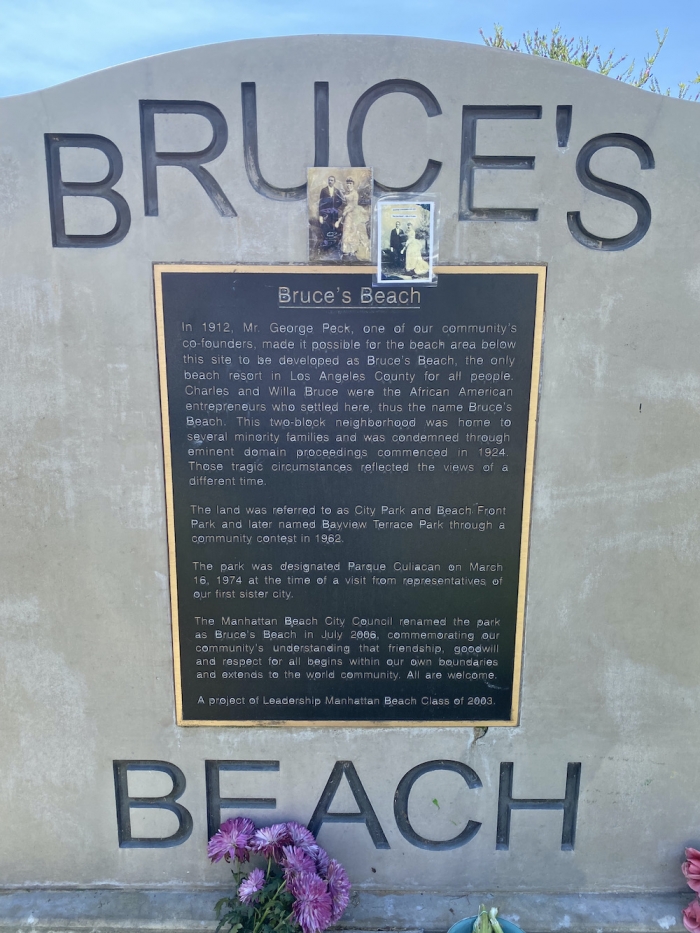
The Los Angeles County Board of Supervisors approved a state grant deed modification that clears the way for the county to transfer Bruce’s Beach — a piece of Manhattan Beach coastline stripped away from its Black owners nearly a century ago — to the descendants of Willa and Charles Bruce.
Supervisor Janice Hahn, who championed the plan to see the heirs take control of the property that was seized by Manhattan Beach through eminent domain, said the ball is now back in the county’s court.
She called the board’s approval “one final step before we right this historic wrong.”
Hahn also noted that because of redistricting, she no longer represents Manhattan Beach, which now sits in Supervisor Holly Mitchell’s Second District.
“This is a very tangled web that we are unweaving,” Mitchell said.
“I look forward to taking the baton and leading as we go forward to figure out what the next steps will be for the county.”
The board directed the county CEO in October to work with staff from the Treasurer and Tax Collector’s Office to identify and vet potential claimants. The county also needs to determine with the family how to transfer the property in a way that eases the property tax burden on the descendants
when they take possession.

(BRANDON I. BROOKS / LA SENTINEL)
The state law gives the county the leeway to handle the transfer however it determines to be in the best interest of the county and the general public.
Hahn said she hoped the transfer of Bruce’s Beach would serve as an example to others.
“We will be a model for the country in how you can right a wrong, even if it’s 100 years old,” Hahn said. “I hope we spend the next 100 years in this country looking at all the possible opportunities we have to tell the truth and then reconcile and amend and heal.”
The public seizure of the property has long stained the history of Manhattan Beach, and has been a particular focus of attention in the past couple of years amid a nationwide reckoning on racial injustice.
Jessa Williams, a Los Angeles resident and Black surfer, told the board in October that it was about much more than this particular piece of land.
“The average white family has 10 times the amount of wealth as the average Black family, white college grads seven times more wealth than Black college grads,” Williams said. “No amount of personal responsibility, hard work or bootstrapping can erase this wealth gap, and this history paints a picture of how and why we’re here.”
Williams’ statements are supported by research from the Brookings Institution.
“It’s more than just beachfront property that was taken, it’s generations of opportunity that was stolen,” she told the board.
Willa and Charles Bruce purchased their land in 1912 for $1,225. They eventually added some other parcels and created a beach resort catering to Black residents, who had few options at the time for enjoying the California coast.
Complete with a bath house, dance hall and cafe, the resort attracted other Black families who purchased adjacent land and created what they hoped would be an oceanfront retreat.
But the resort quickly became a target of the area’s white populace, leading to acts of vandalism, attacks on vehicles of Black visitors and even a 1920 attack by the Ku Klux Klan.
The Bruces were undeterred and continued operating their small enclave, but under increasing pressure, the city moved to condemn their property and surrounding parcels in 1924, seizing it through eminent domain under the pretense of planning to build a city park.
The resort was forced out of business, and the Bruces and other Black families ultimately lost their land in 1929.
The families sued, claiming they were the victims of a racially motivated removal campaign. The Bruces were eventually awarded some damages, as were other displaced families. But the Bruces were unable to reopen their resort anywhere else in town.
Despite the city claiming the land was needed for a park, the property sat vacant for decades. It was not until 1960 that a park was built on a portion of the seized land, with city officials fearing the evicted families could take new legal action if the property wasn’t used for the purpose for
which it was seized.
The exact parcel of land the Bruces owned was transferred to the state, and then to the county in 1995.
The city park that now sits on a portion of the land seized by the city has borne a variety of names over the years. But it was not until 2006 that the city agreed to rename the park “Bruce’s Beach” in honor of the evicted family, a move derided by critics as a hollow gesture.







